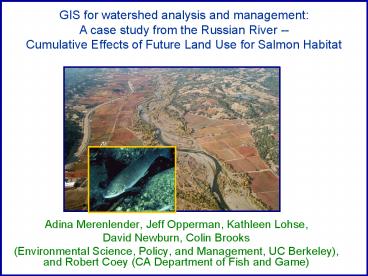Adina Merenlender, Jeff Opperman, Kathleen Lohse, - PowerPoint PPT Presentation
1 / 23
Title: Adina Merenlender, Jeff Opperman, Kathleen Lohse,
1
GIS for watershed analysis and management A
case study from the Russian River -- Cumulative
Effects of Future Land Use for Salmon Habitat
- Adina Merenlender, Jeff Opperman, Kathleen Lohse,
- David Newburn, Colin Brooks
- (Environmental Science, Policy, and Management,
UC Berkeley), and Robert Coey (CA Department of
Fish and Game)
2
Without a forward-looking, predictive analysis,
the invevitable consequence is that each forest
conversion will be seen in its own narrow
context, and be described as just another small
drop in the bucket, with the hard decision about
limiting or modifying activities being handed off
progressively into a receding future.
3
A Scientific Basis for the Prediction of
Cumulative Watershed Effects (Dunne et al. 2001)
- Today
- What are cumulative watershed effects?
- What needs to be done to measure them?
- Examples from our newest research on land use
change and stream habitat that may help.
4
What are cumulative watershed effects (CWE)?
- Cumulative effects two or more influences of
land use, or changes on two or more parcels of
land, can interact to produce a magnified effect
on the functioning of an ecosystem or other
resource. - CWE are significant, adverse influences on water
quality and biological resources that arise from
the way watershed functions, and particularly
from the ways that disturbances within a
watershed can be transmitted and magnified within
channels and riparian habitats downstream of
disturbed areas. - there is no agreed upon methodology.
5
Related facts about CWEs
- Must consider past and probable future activities
and conditions. - Generally, the larger the proportion of land
surface disturbed the larger the downstream
impact. - CWEs are diffuse in space and irregular in time.
- Past cumulative effects are often acknowledged
but future ones are always believed to be
nonexistent.
6
Russian River Basin
7
Hill slope soil erosion
8
(No Transcript)
9
Embeddedness
- Embeddeness an assessment of the degree to which
fine sediments surround spawning gravels - measured at the pool-tail crest of each pool in a
reach - 1 (very low) to 4 (very high)
- Embeddedness Index within a reach
- EI ( of 4s) ( of 1s)
- EI ranges from -100 to 100
- Use reaches with 10 pools or more
10
Embeddedness data
- 258 reaches/379 surveyed prior to 2000
11
Does land use influence embeddedness?
- Streams integrate influences across multiple
scales. - Response reaches are most likely influenced by
elevated levels of sediment. - Analyzed all reach 1s (lowest) with gradient lt3
and with gt10 pools.
12
54 Watersheds
13
Significant results
22 watershedsgt2,500 hectares
- Variables
- 1994 LULC from Cal Veg
- Agriculture
- urban
- geology
- herbaceous, forest, shrub
- housing density
- roads
- soil particle size
- aspect
- elevation
- slope
- precipitation
- forestry practices
14
Spatial land use change model
- Land use data
- Baseline parcels in extensive use (pasture,
timber, etc.) in 1990 - Land use transitions for 1990-2000
- Transition categories extensive, vineyard,
residential - Land use change model
- Multinomial logit for land use transitions (500
randomly selected parcels) - Determinants of land use conversion linked to
each parcel using GIS - Probdevelop f(slope, zoning, distance to
urban centers ) - Relative probability map of developable
parcels converted to vineyard or residential - Overall accuracy 73.7
- Vineyard probability
- decreases with slope
- increases with growing degree days
- Residential probability
- decreases with travel time to urban centers
- decreases in floodplain areas
- strongly influenced by lot size
15
Predicted vineyard probability surface for all
parcels in the unincorporated portion of Sonoma
County
16
Predicted residential probability surface for all
parcels in the unincorporated portion of Sonoma
County
17
(No Transcript)
18
(No Transcript)
19
Estimating the change to the embeddedness index
(EI)
- Large (gt2,500 ha) watersheds in Sonoma Co (N15)
- 1 of the watershed changed land use (N12)
- Post-change calculated using regression equation
- EI1.9 178.90(prop ag) 160.70(prop urban)
56.97(prop Franciscan melange and schist)
59.32(prop tertiary volcanic)
20
(No Transcript)
21
(No Transcript)
22
Next Steps
- Trying to improve model for large and small
watersheds - Forest practices
- Could estimate EI for any response reach
- Need gradient
http hopland.uchrec.org
23
(No Transcript)

